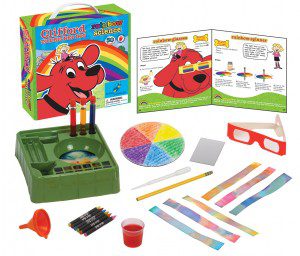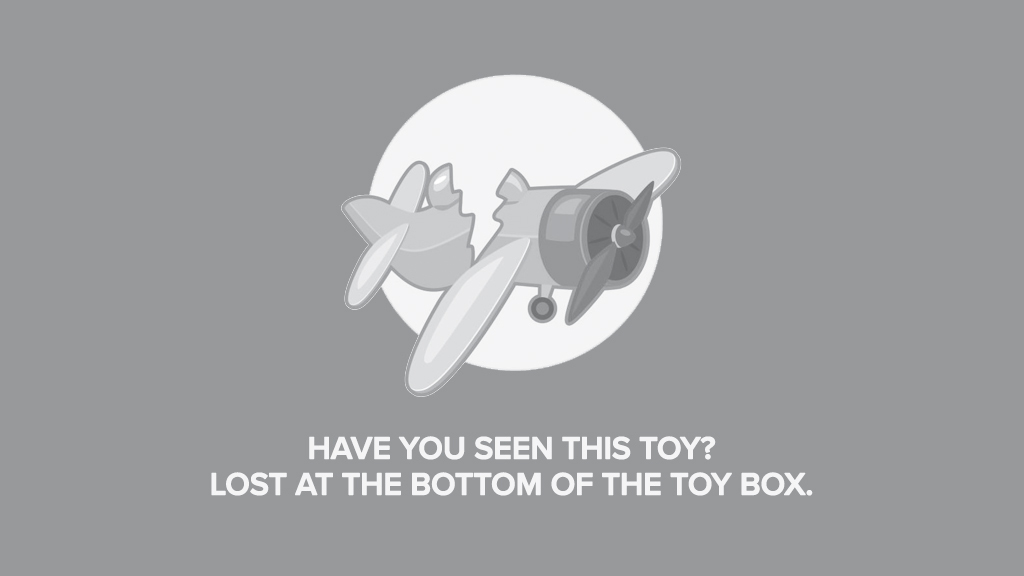 Clifford The Big Red Dog is such a classic, lovable cartoon character, so it is fitting that Scholastic has a Clifford-themed science kit about something as spectacular as rainbows. Who doesn’t love to look to the sky and see an array of colors that seem to have magically appeared there after a rainy day? I know I sure do—almost as much as I loved Clifford growing up. Clifford The Big Red Dog Rainbow Science, part of The Young Scientists Club, is for ages 3 and up and is an experiment kit that teaches kids the science behind rainbows, while encouraging them to take an active role in their learning. Included in the kit is an informative manual advising close adult supervision for all experiments, and all the materials: a pipette, three test tubes, a funnel, test tube holders, wells, six pieces of chromatography paper, crayons, rainbow glasses, a measuring cup, a pencil, a mirror, and a white circular cardboard. Common household materials are needed for the experiments as well. The bottom of every experiment page provides explanation for the outcome and there are illustrations outlining each step to every experiment, which I found to be very helpful once I was actually experimenting.
Clifford The Big Red Dog is such a classic, lovable cartoon character, so it is fitting that Scholastic has a Clifford-themed science kit about something as spectacular as rainbows. Who doesn’t love to look to the sky and see an array of colors that seem to have magically appeared there after a rainy day? I know I sure do—almost as much as I loved Clifford growing up. Clifford The Big Red Dog Rainbow Science, part of The Young Scientists Club, is for ages 3 and up and is an experiment kit that teaches kids the science behind rainbows, while encouraging them to take an active role in their learning. Included in the kit is an informative manual advising close adult supervision for all experiments, and all the materials: a pipette, three test tubes, a funnel, test tube holders, wells, six pieces of chromatography paper, crayons, rainbow glasses, a measuring cup, a pencil, a mirror, and a white circular cardboard. Common household materials are needed for the experiments as well. The bottom of every experiment page provides explanation for the outcome and there are illustrations outlining each step to every experiment, which I found to be very helpful once I was actually experimenting.
The first two experiments are dubbed “milk rainbow” and “rainbow star.” Both call for milk to be poured into the provided plastic bowl and for kids to add a drop of yellow, red, and blue food coloring (which must be provided from home). The child is than instructed to add one drop of liquid dish soap to the middle of the bowl. The point of these experiments is to show kids the liquid soap breaking the surface tensions of the milk, causing the color droplets to mix together and in with the milk. The next few pages of the manual feature experiments that teach kids how to use and clean the pipette properly, be creative and come up with their own secondary colors from primary colors, and decorate the chromatography paper provided from the kit. The next three experiments use vegetable oil, which must also be provided from home. The purpose of the “colored bubbles in oil,” “rainbow color explosions,” and “colored bubbles in a tube” experiments are to show kids that since oil and water don’t like to mix, the watered food color will not dissolve into the oil, causing bubbles to form and even explode when the oil and water are mixed in one of the test tubes.
 The experiments “catching a rainbow” and “ceiling rainbow” stay true to their names and simply use a glass of water and sunlight as the foundations for creating the rainbows that appear on a piece of white paper and the ceiling. The kit also comes with rainbow glasses, which have tiny holes in their plastic lens. When the light from a light bulb is forced through the little holes, the light bends each color differently, so a rainbow is seen all around. The next experiment may be simple, but definitely one of the coolest. The steps instruct kids to color the circular cardboard into blue, purple, red, orange, yellow, and green parts. A pencil is to be pushed through the middle and held, while the cardboard is now spun fast like a top. The circular cardboard starts to look white while spinning, but the colored light waves that come from the circular cardboard are really just mixing together and forming white light. I found this to be one of the most fascinating experiments in the kit.
The experiments “catching a rainbow” and “ceiling rainbow” stay true to their names and simply use a glass of water and sunlight as the foundations for creating the rainbows that appear on a piece of white paper and the ceiling. The kit also comes with rainbow glasses, which have tiny holes in their plastic lens. When the light from a light bulb is forced through the little holes, the light bends each color differently, so a rainbow is seen all around. The next experiment may be simple, but definitely one of the coolest. The steps instruct kids to color the circular cardboard into blue, purple, red, orange, yellow, and green parts. A pencil is to be pushed through the middle and held, while the cardboard is now spun fast like a top. The circular cardboard starts to look white while spinning, but the colored light waves that come from the circular cardboard are really just mixing together and forming white light. I found this to be one of the most fascinating experiments in the kit.
The final experiment in the manual, the “rainbow explosion,” uses baking soda as a base (with added food coloring) and vinegar as an acid, resulting in a chemical reaction that causes fizzing rainbow bubbles! Before experimenting with Clifford and Emily Elizabeth, I wasn’t aware that you could get colored water bubbles to explode in a mixture with water, or that a spinning colored cardboard circle would look white because of light waves. Educational, entertaining, and sure to keep children occupied for long periods of time, this rainbow science kit is a must have!
For more commentary from Lindsay, check back often. Views expressed in this column are solely those of the author and do not necessarily reflect the views of The Toy Book as a whole. We hope that you will share your comments and feedback below. Until next time!

